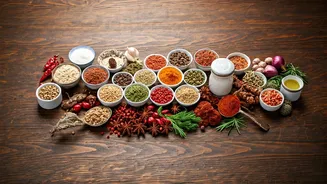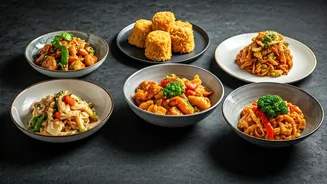Global Culinary Landscape
The culinary landscape around the globe is incredibly diverse. Each region boasts its unique cooking styles, recipes, and ingredients. These reflect a history
of migrations, trade, and cultural exchanges that have shaped the tastes we savor today. These dishes are more than just food; they are an expression of history, identity, and the environment that shaped them. The use of certain spices, cooking techniques, and ingredients is influenced by climate, geography, and local resources. Whether it's the use of rice in many Asian cuisines, or the influence of herbs in Mediterranean ones, food offers a glimpse into a culture's past and present.
Asia's Flavorful Variety
Asian cuisine, a vast and varied culinary continent, is renowned for its use of spices, fresh ingredients, and diverse cooking techniques. From the complex curries of India to the delicate sushi of Japan, each region has its unique character. Chinese cuisine, with its regional variations like Sichuan and Cantonese, showcases a range of flavors, from spicy to sweet and savory. Southeast Asian food, including the well-known Vietnamese pho or Thai green curry, highlights the use of herbs, chilies, and coconut milk. This continent demonstrates the intricate balance of flavors, often using sweet, sour, salty, and spicy notes in a single dish, is a common feature that creates a truly unforgettable experience for the diner.
European Culinary Traditions
European culinary traditions are characterized by their rich history, regional variations, and emphasis on fresh, local ingredients. Mediterranean cuisine, embraced across countries like Italy, Greece, and Spain, highlights olive oil, fresh vegetables, and seafood. French cuisine, known for its sauces and pastry, often uses butter, cream, and complex cooking methods. The central European countries present hearty dishes, such as German sausages and stews, representing traditions that reflect the seasonal availability of ingredients, culinary techniques developed over centuries, and cultural values connected to food. These cuisines focus on the balance between flavors, textures, and presentation.
The Americas' Diverse Flavors
The Americas offer a diverse tapestry of flavors, from North to South, each reflecting unique cultural influences. North American cuisine, influenced by Native American, European, and African traditions, has seen the rise of comfort food, barbecue, and regional specialties. Latin American cuisines present a mix of influences, with Mexican food known for its tacos and rich sauces, while Brazilian cuisine includes feijoada and grilled meats. The Caribbean islands exhibit a unique blend of flavors, with Jerk chicken and rice and peas being popular. The Americas' culinary diversity reflects a melting pot of cultures, shaped by geographical, historical, and economic influences.
Food Trends: Global Impact
Globalization has significantly impacted global food trends. Increased travel and the spread of information have led to the popularity of international cuisines worldwide. Health-conscious eating, including vegan and vegetarian diets, has led to innovative dishes and ingredient substitutions. The rise of social media has boosted food photography and recipe sharing, encouraging experimentation and culinary adventures. As consumers become more aware of food origins, sustainability and ethical sourcing are becoming key. This is driving changes in farming practices, production methods, and consumer choices.
Ingredients And Techniques
The global palette of ingredients ranges from staple foods, such as rice and corn, to exotic spices, like saffron and turmeric. Regional variations of cooking techniques also shape flavors. Grilling, roasting, and frying are common in many cultures, as are methods such as fermentation and pickling. The use of specific cooking utensils, such as the wok in Chinese cuisine and the tagine in Moroccan cooking, can also change how a dish tastes and looks. The combination of ingredients and techniques reveals cultural influences, adapting to the availability of the foods and environmental conditions of a particular location, offering a variety of gastronomic experiences.
The Future of Food
Looking ahead, the future of food is predicted to be defined by sustainability, health, and technology. Sustainable practices, like reducing food waste and supporting local farmers, will gain even more importance. Plant-based diets and alternative proteins, such as lab-grown meats, are expected to grow. Technology will play a major role, with AI-driven recipe generation, personalized nutrition advice, and improved food distribution methods. The food industry must find innovative ways to feed a growing population while minimizing environmental impact. By embracing these changes, the food industry can look forward to a healthier and more sustainable future.














